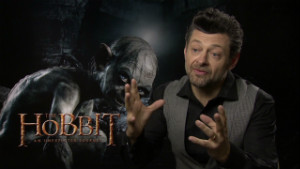The Art of Movement is
a monthly show that highlights the most significant innovations in
science and technology that are helping shape our modern world.
(CNN) -- He's the face of motion-capture performance.
Whether it's as the
nefarious and rather grotesque "Gollum," Tintin's beloved best friend
and sidekick, the grouchy "Captain Haddock," or more recently the
intellectually enhanced chimp ringleader "Caesar" from the "Planet of
the Apes" franchise, Andy Serkis is synonymous with the groundbreaking
movie technique.
Over the years countless
fans and fellow actors -- including Serkis' "Rise of the Planet of the
Apes" co-star James Franco -- have called for the motion-capture pioneer
to receive an Oscar for bringing his characters to life. So far to no
avail.
 Andy Serkis on acting
Andy Serkis on acting
 'Hobbit' stars weigh in on 3-D critics
'Hobbit' stars weigh in on 3-D critics
Online devotees argue
that Serkis' Oscar "snubs" come from the fact that the Academy Awards
judges are wary of motion-capture performances. Whether or not that is
true, not many truly understand how the British actor and other "mo-cap"
performers achieve such sincerely emotional portrayals of
computer-generated protagonists.
"I think our ability to
have actors now on stage playing other creatures or on location on set
has been fantastic both for the creatures they're portraying and, you
know, perhaps the human characters they're playing off in the scene,"
explains Dan Barret, animation supervisor at Weta Digital,
the New Zealand-based digital effects firm that worked on "Dawn of the
Planet of the Apes," "Tintin," "The Hobbit" and many other blockbusters.
"It's improved
performances and opened up a whole lot of opportunities as far as how
much work we can get through, how much motion we can get," says Barret.
"Generating all of this stuff with key frames can take a long time. It's
been a huge revolution."
Weta
Digital has helped produce box office gold with the last five films
they created digital effects for turning into blockbuster smash hits.
Lauren Said-Moorhouse & Inez Torre/CNN
The motion-capture
process begins with actors dressed in slimline, tight-fitting body suits
adorned with over 50 strategically placed tracking markers, which allow
computers to detect where various body parts are while following the
precise movement of the performer.
Unlike traditional
animated CGI, motion-capture technology is not a frame-by-frame process.
It requires actors to perform in the distinctive body suits to provide a
fluid model for animators to tweak and transform digitally. While "mo
cap" performances offer a new level of authenticity, actors still need
to use all their skills and training to enhance and make their
performances more believable for cinemagoers.
And skilled motion-capture performances were key to creating realistic movement in "Dawn of Planet of the Apes," says Barret.
"Apes have a similar
physique to humans and a similar weight. It certainly makes that motion a
lot more believable. It's not that we couldn't do it ourselves as
key-frame animators. It's just that kid of work takes a long time."
He adds: "(Motion
capture) gives us a believable motion a lot quicker and gives us time to
concentrate on what we consider more important things, like maybe
facial performances and things like that."


No comments:
Post a Comment